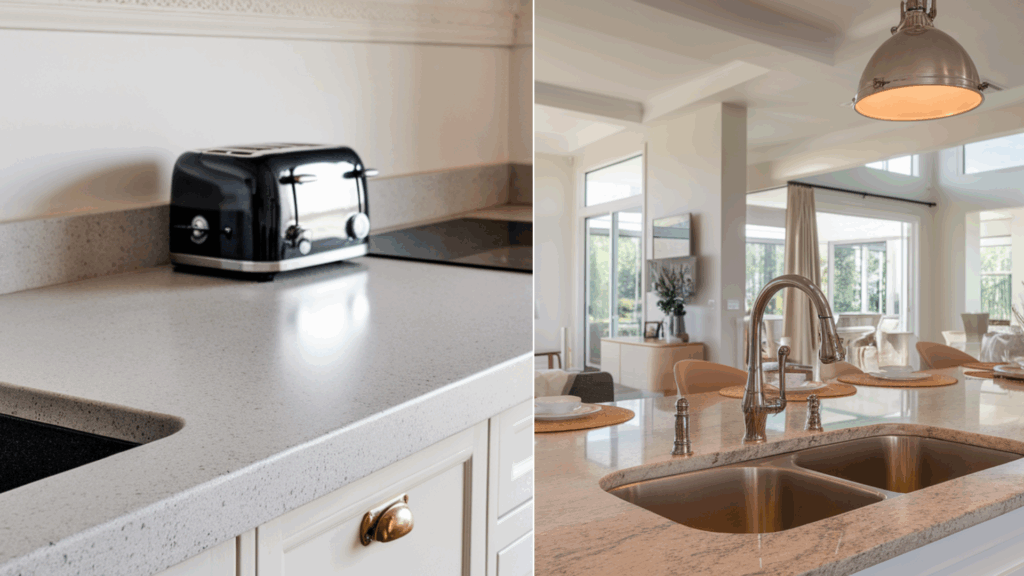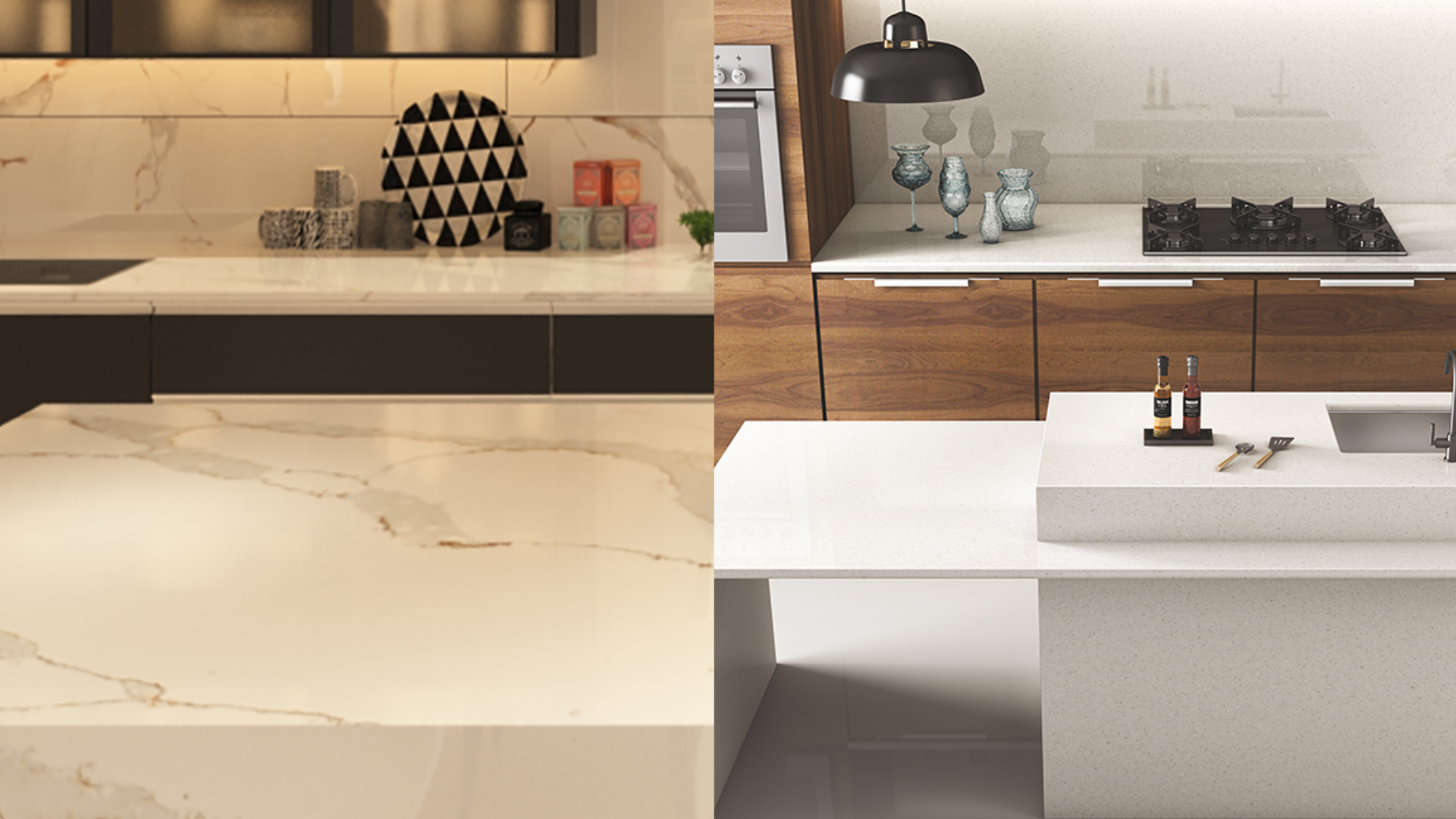When I began my kitchen remodel, I kept encountering the same significant decision: quartz or granite countertops? Both are strong, beautiful, and loved for good reason – but they’re also quite different.
I quickly realized it wasn’t just about looks. It came down to cost, durability, maintenance, and what worked best for my space and lifestyle.
That’s when I dove into the details – comparing everything from daily care and long-term value to color consistency and design flexibility.
If you’re facing the same decision, this guide will help simplify the process. I’ve broken it all down with clear examples, personal insights, and an easy-to-read comparison chart.
Let’s take the confusion out of countertop shopping and help you choose a surface you’ll love for years.
What Is Quartz?
Quartz countertops are engineered surfaces made from approximately 90–95% crushed natural quartz combined with resins, polymers, and pigments.
The result is a non-porous, highly durable material with consistent color and pattern.
Because quartz is manufactured, it offers excellent design flexibility, perfect for homeowners who want a specific shade, finish, or uniform look throughout their kitchen or bathroom.
Unlike natural stone, quartz doesn’t require sealing and is more resistant to stains, scratches, and bacteria.
It’s low maintenance, easy to clean, and ideal for busy households or modern design styles that favor sleek, seamless finishes.
What Is Granite?
Granite is a 100% natural stone formed through volcanic activity and mined from quarries around the world.
Each slab is unique, showcasing intricate patterns, veins, and colors created by mineral deposits. It’s one of the hardest countertop materials available, making it highly resistant to heat, scratches, and general wear.
Granite requires periodic sealing to maintain its stain resistance, but many homeowners love its organic beauty and natural variation.
No two granite slabs are alike, which makes it a great option for creating a custom, high-end look that adds character and depth to any space.
Quartz vs. Granite: Key Differences

Quartz and granite may seem similar, but they differ in important ways – including how they’re made, how they perform, and how they’re maintained.
1. Durability and Strength
Both quartz and granite are durable countertop materials, but their performance under daily wear depends on how they’re made and used.
Quartz is an engineered stone made for strength and consistency. It’s non-porous and dense, which means it resists scratches, chips, and cracking better than many natural materials.
It’s ideal for active households, where surfaces face daily cooking, spills, and cleanup.
Granite is a naturally hard stone with strong resistance to heat and wear. While slightly more prone to chipping at edges, it holds up exceptionally well over time and is trusted for its long-term durability in high-use areas.
2. Appearance and Color Options
Granite and quartz offer completely different visual experiences. Granite features natural movement, mineral variation, and bold colors; no two slabs are ever the same. Quartz, on the other hand, provides consistency.
Quartz often fits best in modern, minimalist designs thanks to its smooth surface and clean patterns. It’s available in solid colors and soft veining that mimics marble or concrete.
Granite, with its earthy tones and natural movement, leans more traditional or rustic.
Coordinating your countertop with cabinets and floors can completely change the room’s look. Dark granite paired with white cabinets creates a bold, elegant contrast.
Always test samples in your home’s lighting, and pay close attention to undertones – those subtle color shifts can greatly impact the final design.
3. Cost Breakdown
The average cost of quartz and granite, including installation and upkeep, helps you understand long-term value and choose the best option for your budget and lifestyle.
Quartz typically ranges from $70 to $120 per square foot installed, depending on the brand and design.
While the upfront cost can be higher than granite, quartz doesn’t require sealing and has low maintenance needs, which may save money over time.
Granite usually costs between $50 and $100 per square foot installed, though exotic patterns may cost more. It offers great long-term value, especially for homeowners who don’t mind occasional sealing.
Granite’s natural beauty and wide range of pricing make it a flexible choice for many budgets, and its durability means it can last for decades with proper care.
4. Heat and Scratches
Granite and quartz are both durable, but they react differently under heat and sharp tools. This section shows how well each surface holds up in a busy kitchen.
Granite is naturally heat-resistant, and it can handle hot pots and pans directly without damage. It’s also quite scratch-resistant, though cutting boards are still recommended to protect your knives and the finish.
Quartz is tough, but not heatproof. High temperatures can damage the resin used in manufacturing, so trivets or pads are a must. It resists scratches well under normal use, but heavy abuse can leave marks over time.
5. Maintenance and Cleaning Needs
Understanding how quartz and granite behave in daily use helps you choose the right surface for your lifestyle. This section covers sealing, stain resistance, and simple cleaning routines.
Quartz is non-porous, so it resists stains, bacteria, and moisture without needing sealing. Daily cleaning is easy, just use a soft cloth with mild soap and water.
It’s a great low-maintenance choice for busy households or anyone who prefers simple care.
Granite is porous and needs sealing once a year or as recommended. Without it, liquids like wine or oil can seep in and stain. With regular sealing and gentle cleaners, granite stays beautiful and durable for decades.
6. Resale Value and Buyer Preferences
Countertops play a big role in how potential buyers perceive a home. Here’s how quartz and granite can influence resale value and appeal.
Quartz appeals to buyers who want modern style and low-maintenance living. It’s often seen as an “upgrade” in listings and can make a home feel updated and move-in ready, especially in newer or renovated properties.
Granite is valued for its natural beauty and timeless charm. Many buyers appreciate its uniqueness and strength, especially when the slab complements the kitchen or bath design.
7. Environmental Impact and Sustainability
Both quartz and granite have pros and cons when it comes to sustainability. This section compares the environmental impact of each material, from production to installation.
Granite is 100% natural but must be quarried and transported, often over long distances. This process uses significant energy and can impact local ecosystems. However, granite lasts for decades, which can reduce long-term waste.
Quartz is engineered using natural quartz and resins, some of which are synthetic. But many brands now use recycled materials and energy-efficient production.
Because it’s non-porous and long-lasting, quartz can be a more sustainable choice in the long run, especially if locally sourced.
Quick Comparision
| Feature | Quartz | Granite |
|---|---|---|
| Material Type | Engineered stone (90–95% natural quartz + resins) | 100% natural stone |
| Appearance | Uniform, consistent colors and patterns | Unique, natural patterns with mineral flecks |
| Color Range | Wide range of solid and blended colors | Wide range, often bolder and more varied |
| Durability | Very hard and scratch-resistant | Extremely durable; slightly softer than quartz |
| Heat Resistance | Good – resists heat, but trivets are recommended | Excellent – can handle hot pots and pans |
| Stain Resistance | Non-porous; resists stains without sealing | Porous; requires sealing to prevent stains |
| Maintenance | Low – no sealing needed; cleans with soap and water | Moderate – needs periodic sealing; also cleans easily |
| Cost | Moderate to high, depending on brand and style | Moderate to high, depending on rarity and thickness |
| Installation | Requires professional installation | Requires professional installation |
| Environmental Impact | Manufactured; some brands use recycled materials | Mined from quarries; higher energy to extract and transport |
Which One Should You Choose: Granite or Quartz?
Choosing between granite and quartz comes down to your lifestyle, design taste, and maintenance preference.
Granite: Natural and Timeless
- Unique Look: Each slab has natural patterns and earthy tones, great for traditional or rustic styles.
- Heat-Resistant: Handles hot pots and pans with ease—ideal for frequent cooking.
- Needs Sealing: As a porous stone, it requires occasional sealing to prevent stains.
- Varied Price Range: Comes in both affordable and premium options, depending on the stone.
Quartz: Sleek and Low-Maintenance
- Modern Style: Smooth, consistent patterns make it perfect for minimalist or contemporary kitchens.
- Non-Porous: Resists stains and doesn’t need sealing – just wipe clean.
- Durable and Chip-Resistant: Great for busy homes and everyday use.
- Higher Upfront Cost: Often more expensive than granite, but easier to care for long term.
Conclusion
When I was choosing between quartz and granite for my home, I quickly learned it wasn’t just about looks – it was about how each surface fit my lifestyle.
I picked quartz for my kitchen because I needed something easy to clean and low maintenance.
But for the guest bathroom, I went with granite because I loved the natural patterns. Both have real strengths, and your choice depends on what matters most to you: durability, style, upkeep, or cost.
If you’re still unsure, get a few samples and see how they look in your lighting. Trust your gut and how you want the space to feel. You’ll be living with this surface every day, so it should work beautifully for you.
Still have questions? I’m here to help – let’s find the best fit for your home together.

